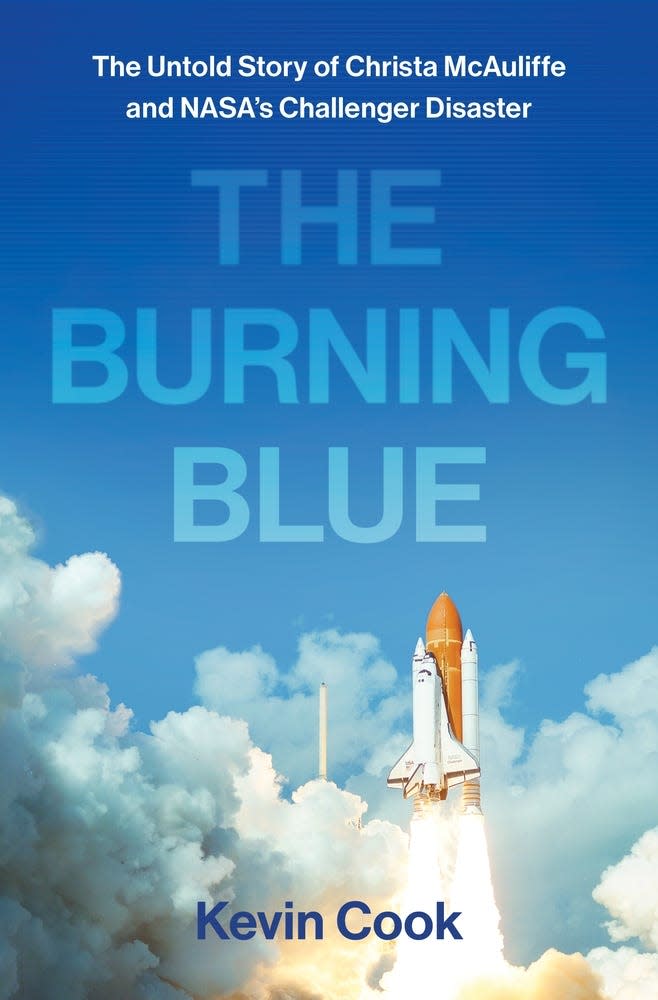In 'The Burning Blue,' Kevin Cook traces the riveting, tragic arc of Challenger disaster
- Oops!Something went wrong.Please try again later.
- Oops!Something went wrong.Please try again later.
After decades of American diversions and disasters, the explosion of the space shuttle Challenger soon after blastoff on Jan. 28, 1986, may be a dimming memory for most of us, but Kevin Cook brings the moment vividly to mind with “The Burning Blue: The Untold Story of Christa McAuliffe and NASA's Challenger Disaster” (Henry Holt and Co., 288 pp., ★★★★ out of four). Cook’s crisply crafted journalism and perceptive take on the personalities that shaped the Challenger mission – along with NASA’s struggles and failures – make for a riveting narrative and complex cross-weave of themes.
Celebrity, bureaucracy, political will, industrial design and unthinkable doom: the ingredients that propel this book like the liquid hydrogen and oxygen that fueled Challenger’s rocketry are superbly balanced in Cook’s telling. The mission is best remembered for its most celebrated crew member, New Hampshire social studies teacher Christa McAuliffe, who brought a relatable, unglamorous charm to the adventure. McAuliffe was widely promoted in the press and on TV, in a public relations coup for a space program the public had lost interest in since the first moon landing in 1969.

Yet the six other crew members are no less memorable – this was the most diverse grouping in NASA history, including the second woman in space (after Sally Ride) and first Jewish female astronaut, the lauded engineer Judith Resnik; the second Black astronaut, Ronald McNair; and the first Asian American and Buddhist to blast off, Ellison Onizuka. We come away dazed and saddened by the cultural complexity that humanizes all the scientific rigor behind space exploration and the myriad things that can – yet rarely do – go catastrophically wrong.
Much has been written about Challenger, while official investigations have probed it in depth. Cook drills into this body of research with keen focus, freshly sourcing via interviews with scientists, astronauts, crew members’ families and NASA records. The book speaks with an authority belied by its compact 200-plus pages, while the lean efficiency of Cook’s writing connects us to the backstory and character of the crew members without sentimentalizing them, along with the crucial forensic details.
He chronicles the infamous failure of the O-rings, the rubber seals connecting the segments of the fuel-filled booster rockets that lifted Challenger toward space. As Cook clarifies, the damning evidence that O-rings might cause explosive fuel leakage in cold temperatures was known by NASA scientists even as NASA yielded to political and media pressure to launch on an unusually cold weekday at Cape Canaveral, Florida – in part to ensure the broadcast of “Teacher in Space” McAuliffe’s triumph to the nation’s schoolchildren during classes.
5 books not to miss: Danielle Henderson’s ‘The Ugly Cry,’ ‘Night Came With Many Stars’
If anything, Cook’s revelatory reconstruction of Challenger’s final moments, written from the point of view of the seven-member crew, transforms our sense of the disaster from abstraction to reality. We learn – cinematically, horrifyingly, shatteringly – that the crew remained alive for about two minutes after the initial explosion over the Atlantic, frantically throwing emergency switches, while Challenger fell like a stone toward oceanic oblivion.
“Viewers believed that nobody could survive such a conflagration,” Cook writes of the televised moment when the soaring rocket seemed to vanish in a vaporous zig-zag. “But the crew did not burn up. The shuttle’s skin of heat-resistant silicon tiles, made to withstand the hellfire of reentry, protected them. There was no fire inside the crew cabin … (as) the crew heard Mike Smith say, “Uh-oh” as the shuttle got an unexpected boost: two million pounds of thrust from the explosion of the external tank…”
Astronaut Smith’s underplayed “uh-oh,” the last thing heard from Challenger, looms like a laconic epitaph over Cook’s unforgettable narrative, as he confronts us with the full measure of an American tragedy.
Review: Clint Smith reckons with America's racial history in necessary 'How the Word Is Passed'
This article originally appeared on USA TODAY: 'The Burning Blue': Kevin Cook traces the arc of Challenger disaster

